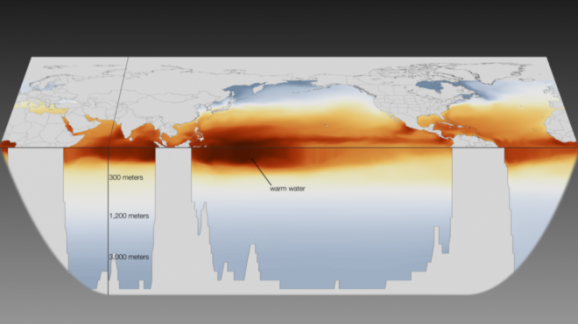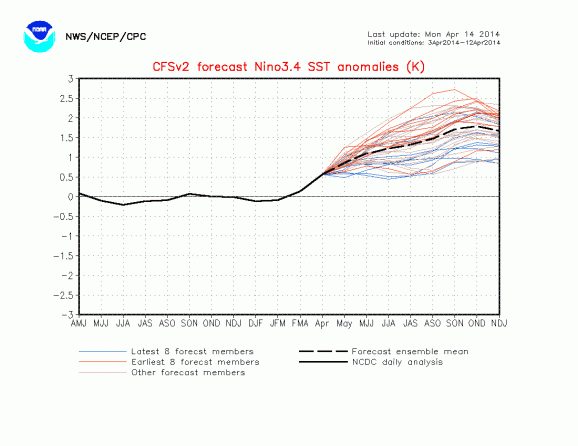El Nino Could Make Another Appearance Later This Year
This article is more than 2 years old
 After this brutal, seemingly endless winter, we better be in for a summer of sunny days and warm temperatures. I know I’m deluding myself, Boston summers are humid and swampy, but a girl can dream, right? That is, until scientists had to go and announce that El Nino might return this year. All I ask is that my perfect summer not be compromised.
After this brutal, seemingly endless winter, we better be in for a summer of sunny days and warm temperatures. I know I’m deluding myself, Boston summers are humid and swampy, but a girl can dream, right? That is, until scientists had to go and announce that El Nino might return this year. All I ask is that my perfect summer not be compromised.
El Nino, the warm phase (La Nina is the cool phase), is a recurring weather pattern associated with warmer ocean temperatures, particularly in the Pacific. The results are often dramatic, and include everything from floods to droughts. Generally, surface pressure rises around Australia, Indonesia, and the Indian Ocean, while air pressure falls over the central and eastern Pacific. South Pacific trade winds are affected. They move east and/or decrease, and as the warm water moves from west to east, the western Pacific experiences drought and the eastern Pacific sees a huge increase in rainfall—as well as mudslides and all of those fun rain-related events. All of this also impacts fishing, among other trades.
The National Oceanic and Atmospheric Administration (NOAA) says there’s a 50% chance El Nino will return this year, especially since the Pacific trade winds have already reversed direction and begun the requisite warming. If El Nino does return, it might be big, comparable to the one in 1997-1998 (1998 was the warmest year we have on record). So what might this mean, exactly? Do you want the good news or the bad news first?
 First off, we’re talking about weather changes that start in the fall and will be in full effect through the winter. So here in Boston we can’t blame the stickiness on El Nino, at least, not in July. On the positive side, the Midwest and East Coast could experience weather that’s both drier and warmer than usual in the fall, which would be fine by me. Along with that, the Atlantic hurricanes could decrease in number and in severity. Some believe, though, that tornado seasons are worse. Increased rainfall from this weather pattern could solve California’s drought problems. Of course, that may also result in flooding and mudslides. The same goes for Mexico. Droughts wouldn’t be alleviated everywhere. Parts of Africa and Australia would likely bake and struggle, though the monsoons in Indian and Indonesia would be weaker.
First off, we’re talking about weather changes that start in the fall and will be in full effect through the winter. So here in Boston we can’t blame the stickiness on El Nino, at least, not in July. On the positive side, the Midwest and East Coast could experience weather that’s both drier and warmer than usual in the fall, which would be fine by me. Along with that, the Atlantic hurricanes could decrease in number and in severity. Some believe, though, that tornado seasons are worse. Increased rainfall from this weather pattern could solve California’s drought problems. Of course, that may also result in flooding and mudslides. The same goes for Mexico. Droughts wouldn’t be alleviated everywhere. Parts of Africa and Australia would likely bake and struggle, though the monsoons in Indian and Indonesia would be weaker.
Another aspect meteorologists are worried about is the interaction between El Nino and climate change. In 1997-1998, CO2 levels were lower than they are now, and weather patterns have continued to shift since then. Some predict that 2015 might knock 1998 off the podium as the warmest year on record. These predictions presume that El Nino will in fact occur, and that it will be as strong as early evidence indicates. But as we all know, long-term weather forecasts aren’t so different than playing the tables at Vegas. The probabilities can be tough to discern, and they don’t necessarily dictate the final outcome. We should know more by June, when this story either slips quietly away, or people start freaking out about the Nino-pocalypse.












